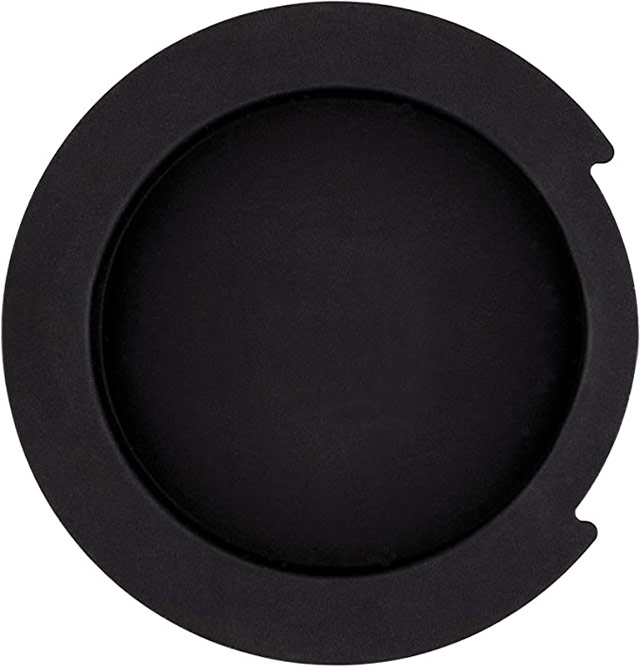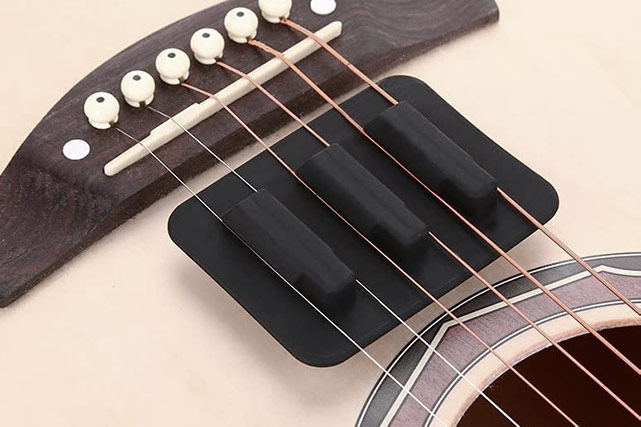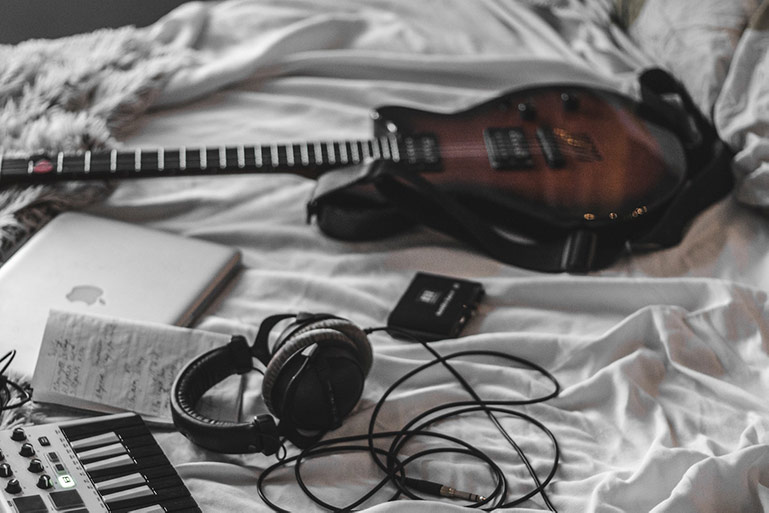Practicing guitar is a tough job, especially in the beginning stages. You don’t sound good, and your family members, roommates, or neighbors don’t enjoy your practice sessions as much as you do. This is an even bigger issue if you live in an apartment complex or anywhere where your neighbors are living in very close proximity to you.
It is understandable for you to try to get as much practice in, even at night, if that’s when you’re free or most comfortable. But others might not appreciate your night-time efforts too much. In this article, we’ll look at ways to practice both electric and acoustic guitar quietly in a manner you still get the most out of your practice.
The simplest way to practice electric guitars quietly is to play them unplugged, but the downside is they don’t sound “electric” that way and, for many people, just plain not good.
The other method is to connect your headphones to the amp or effect pedals. This way, you get the proper sound of the electric guitar but without making any sound. There are even more ways that might suit you better, which we’ll learn here.
You can try palm muting or using your fingers instead of a pick for acoustic guitars. There are also specific devices available that will muffle the sound so you can practice without making too much sound.
How to Practice Electric Guitar Quietly
Electric guitars are quiet instruments when not plugged in. However, there are other ways to practice electric guitars quietly without having to compromise on the sound output or the tone.
Practice with Headphones Connected to the Amp
Practicing with headphones connected to your amp will provide you with the same sound output as your amp. You’ll also be able to use all your effect pedals and the tone adjustment controls on your amp. This makes this method one of the best ways to practice guitar if you’re at home and want to maintain your tone and sound output.
All amps have an output jack, a 1/8th inch (3.5mm), or a 1/4 inch jack. If yours has a 1/4 inch jack, you’ll require an adapter to connect your headphones which almost always have a 3.5 mm (1/8 inch) TRS connector. These are cheap, so you should always have one at your disposal.
When a headphone is plugged into the amp, almost all amps will stop the speakers from producing sound. In this state, you’ll be able to use the Volume knob on the amp to turn the headphone volume up or down.
On the other hand, some amps that have audio out from the preamp section will not stop the power amplifier. In such amps, even when a headphone is plugged in, the speakers in the amp will continue producing sound. For these, you should turn the master volume down and adjust the channel volume to control the headphones’ volume.
Use Practice Amp with or without Headphones
Practice amps are portable devices that run on batteries. These are small enough to carry while traveling and can produce enough volume for intimate gigs. They are also very capable in terms of features and offer almost as many onboard controls as an entry-level amp.
You can even plug your headphones into them for extra quiet practice, for example, in hotel rooms, etc. Since these amps are specially meant for practice, some have an Auxiliary input option. You can connect your mobile phones and play jam tracks to practice, and you’ll hear the track and your guitar.
There is little incentive to buy these in addition to having a regular amp especially if you don’t want to practice while traveling or don’t travel often. This could be a decent alternative to buying a traditional amp for someone just starting out. These practice amps offer decent sound quality and features at a lesser price.
Practice with Headphone Amp
Headphone amps are probably the smallest and also the most inexpensive device (only about $50) that you can use to play your guitar through headphones. Something like Vox AmPlug2 offers outstanding sound quality for a device of its size. With a 180-degree movable plug, these can be directly hooked into your guitar. These tiny devices are very capable and offer many controls onboard to shape the sound making practice session fun.
Headphone amps are one of the most useful and value-for-money devices you can buy. And they will help you practice quietly and efficiently irrespective of whether you’re a beginner or an advanced player. What’s more, you can even connect these to your computer speakers or home theater system for a louder sound! While this setup will not replace a dedicated amp, they will still sound decent with good-quality speakers.
Practice Unplugged
While the general suggestion for playing guitar quietly is to use it unplugged, it does not sound necessarily good or like an electric guitar. It is alright if you practice notes or scales or build finger dexterity. But if you’re trying to play riffs and solos, you want your electric guitar to sound like it.
If you’re okay with the sound of an unplugged guitar and don’t necessarily care about all the effects, then, by all means, practice unplugged. Some beginners might even benefit from practicing unplugged as you can hear the nuances in a note more clearly, especially in a quiet room.
But do remember, solid-body electric guitars do not produce much sound when played unplugged, you can hear it clearly, but it would certainly not disturb others. It would sound almost like a muffled and thin-sounding acoustic guitar.
Other Methods to Plug In Your Headphones
There are a lot of other ways to play guitar quietly through headphones.
Effect Pedals
Almost all multi-effects pedals have an output jack for headphones, while others, like preamp pedals, may also have one. Since most pedals are portable and battery-operated, you can use these pedals effectively as a headphone amp. A decent multi-fx pedal should sound as good or better than most headphone amps.
Audio Interface
Audio interfaces connect your guitar to a computer, providing a lot of functionality in the Digital Audio Workstation software. You can record your guitar, play it through the speakers or connect your headphones.
Most of the newer audio interfaces can also connect to mobile phones and offer limited features through the mobile phone. You can still play, record, or hear the guitar through headphones, which could be very useful for people who travel or just want to practice quietly.
How to Practice Acoustic Guitar Quietly
Acoustic guitars make considerably more sound than an unplugged electric guitars. For most beginners, they are also harder to play in the initial stages due to their relatively higher action and bigger string gauge. It may take a little more practice for beginners to get decent at playing an acoustic guitar. Some people are also self-conscious about it until they get to the point where they think they sound good enough.
Here are some tips for practicing or playing an acoustic guitar quietly without disturbing others.
Practice with a Acoustic Guitar Dampener

Also called feedback dampeners, these are small, circular items made of rubber that fit your guitar’s sound hole and dampen or mute the sound. Acoustic guitars rely on acoustics, including the soundboard, the sound hole, and the sound chamber, to transform the strings’ vibration into sound. It is only natural that blocking the sound hole will decrease the sound emitted.
These dampeners are easy to put in place and remove and work quite effectively in reducing the sound, especially the lower end. One downside is that these block the bass frequencies more than the treble frequencies, making the guitar sound more twangy and less fuller. However, this should be fine for practicing.
Practice with a Acoustic Guitar Silencer

These small and inexpensive silencers are made of silicon or rubber and have notches that slide in between the strings. These items work differently than the dampeners. While dampeners change the acoustic property of the guitars to reduce sound production, these thwart the strings from vibrating much.
When these are put on, you get a similar sound output as palm muting but without any extra effort, which is why I like these. However, the downside is the guitar doesn’t sound clean, and it is harder for you to notice the clarity of the tone of your notes or chords. For beginners, it is vital to observe if they are fretting clean notes or chords; therefore, this method is not recommended for them, so try dampeners instead.
Practice with a DIY Guitar Silencer
There are several methods to make a DIY silencer, but from all my experiments, I like two methods. The first is to use a thick sock, put it underneath the strings and slide it close to the bridge. Now, fold over the extra length of the sock from the top so that it stays in place and doesn’t slip through.
This DIY method would mute the strings, much like palm muting. The notes wouldn’t ring much or have much sustain. You can try various socks with different thicknesses to get different sounds.
The second method is to make a string silencer with an old (or new) mouse pad. All you’ll need is a mousepad, a marker pen, and a pair of scissors.
- Put the mouse pad over the strings so that it is parallel to the bridge and mark the total width of the strings with a pen. Leave a couple of inch at the side so that the rounded corners of the pad stay well off.
- Add half an inch at either side of the width and cut it into a small rectangle with a length of around 1.5 inches. So if the string width was 3 inches, you cut the mousepad to size: 4 inches x 1.5 inches.
- Again place it over the strings, and with the marker, mark all the strings on the piece of mouse pad you just cut.
- Slit the markings with scissors about half-an-inch deep. Try to make these slits with even lengths for all the strings.
Your DIY string silencer is ready! To use, slide the slits inside the strings and push them back to the bridge. Now, if you play your guitar, it will be very silent, and you can practice all your techniques, even aggressive strumming, very quietly.
Practice Using Palm Muting
I am not a big fan of this method but it can work in a pinch. For this, you use the side of your palm to hit the strings near the bridge as you strum. You can also keep the palm rested on top, touching the strings for slow strumming.
This technique will need some practice to pull off so that the strings are evenly muted. The trick is to rest the side of the palm lightly and not press it against the strings too forcefully.
The downside of this method is that you must consciously do the muting, especially in the beginning. The upside is you learn a cool technique that guitarists often use!
Use Your Fingers Instead of a Pick
Using your fingers instead of a pick will work very well with the other methods, especially the dampeners and silencers if you want your acoustic to be extra quiet.
Picks are made of plastic and make sharp contact with the strings producing a much louder sound than using your fingers.
For this method, you can press your thumb on the index finger like you’re holding an imaginary pick, then slide your thumb back a bit so that your index finger sticks out. Now, strum the strings with the tip of your index finger. The sound would come out more muffled and less twangy.
Lighter strums with this method will ensure the sound is only audible inside your room, and you can practice quietly without having to worry about disturbing others.
Buy a Silent Guitar

If you’re very serious about your practice and you’re someone that travels much, you can opt for these small travel-sized guitars. Much like regular guitars, there are a wide variety of silent guitars available that look very different from each and from a standard guitar. Some of these are foldable, while others have a small onboard preamp that lets you connect your headphones directly to them.
Almost all of these guitars lack the sound chamber and therefore do not have any acoustics and are very silent, much like a solid-body electric guitar.
Silent guitars work the same way as standard guitars but rely on just the strings’ vibration to produce sound. Some have pickup and onboard electronics for headphone amplification for quiet practice. They are lightweight, compact, and perfect for practicing quietly in hotel rooms or late at night.
A few musicians also use them in performances for their ability to produce heavily amplified acoustic tones without having feedback issues.


